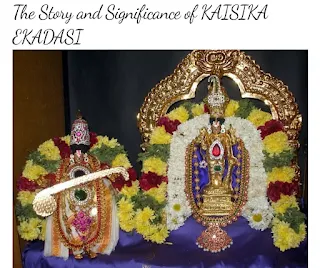Kaishika Dvadasi in Srirangam:
Kaishika Dvadasi is a sacred day celebrated on the Dvadasi Tithi (12th lunar day) of the Shukla Paksha (waxing moon phase) in the Tamil month of Karthigai (November-December). In Srirangam, this day holds immense spiritual importance, rooted in the Kaishika Mahatmiyam, a story from the Varaha Purana, and is celebrated with grandeur.
Kaishika Dvadasi is a day dedicated to Lord Vishnu, emphasizing devotion through singing and narrating divine hymns and stories.
It underscores the power of Kaishika Vrata, a penance and vow of devotion observed on this day.
The Story of Kaishika Dvadasi
The story of Kaishika Mahatmiyam, narrated by Lord Varaha to Bhoomi Devi, highlights the devotion of a simple Brahmin and the Lord's grace. Here's the full account:
In a small village near the temple town of Thirukurungudi (South India), lived a poor Brahmin named Nampaduvan, a great devotee of Lord Vishnu.
Despite his poverty, Nampaduvan spent his life singing the glories of the Lord, especially during the auspicious hours of the night.
The Vrata of Nampaduvan
On the night of Kaishika Ekadasi, Nampaduvan walked to the Vishnu temple in the forest to sing hymns. He observed strict fasting and vowed to sing throughout the night in praise of the Lord.
As he entered the forest, he was confronted by a fierce Rakshasa (demon) who threatened to kill and eat him.
The Dialogue Between Nampaduvan and the Rakshasa
The Rakshasa, drawn to Nampaduvan’s scent, demanded that he surrender to be his meal. However, Nampaduvan pleaded for time, saying:
“Let me fulfill my vow to sing for the Lord on this sacred night. I promise to return to you after that.”
The Rakshasa laughed at him, refusing to believe his promise, but Nampaduvan swore solemnly on the Kaishika Vrata, saying:
“If I fail to return, may I lose all merit from my prayers and devotion to the Lord.”
Nampaduvan’s Return
After completing his Kaishika Vrata by singing hymns at the temple, Nampaduvan kept his word and returned to the Rakshasa.
The demon, astonished by the Brahmin’s honesty, asked why he would willingly return to face certain death. Nampaduvan explained:
“It is my duty to keep my promise, even if it means sacrificing my life. A promise made to another, especially during a vrata, must never be broken.”
The Rakshasa's Transformation
Moved by Nampaduvan’s sincerity and purity of heart, the Rakshasa inquired about his devotion and the hymns he sang.
Upon hearing the divine songs and the glories of Lord Vishnu, the Rakshasa was spiritually transformed.
He revealed his past: he was a Brahmin cursed to become a demon due to his misdeeds. Nampaduvan’s devotion and hymns relieved him of his curse, and he attained liberation (moksha).
Significance in Srirangam
In Srirangam, Kaishika Dvadasi is celebrated to honor this story and the virtues it teaches:
1. Supremacy of Bhakti: The festival highlights that devotion to Lord Vishnu transcends all barriers, including caste, wealth, and even demonic tendencies.
2. Power of Vrata: It emphasizes the sanctity of vows and their ability to transform not only the individual but also others around them.
3. Importance of Divine Hymns: Reciting or listening to the Lord’s names and stories on this day is believed to grant immense spiritual merit.
Celebrations in Srirangam
1. Thirumanjanam and Special Poojas:
A grand Thirumanjanam (holy bath) is performed for Lord Ranganatha.
The deity is adorned with ornaments and flowers and taken in procession within the temple precincts.
2. Recitation of Kaishika Mahatmiyam:
Priests and scholars recite the Kaishika Mahatmiyam story, narrating Nampaduvan’s devotion and the Rakshasa’s transformation.
3. Alwar Pasurams and Devotional Singing:
The Nalayira Divya Prabandham, composed by the Alwars, is sung by temple musicians and devotees throughout the day.
Devotees gather to sing bhajans and hymns, recreating the spirit of Nampaduvan’s devotion.
4. Fasting and Charity:
Devotees observe a fast on Kaishika Ekadasi and break it ceremoniously on Kaishika Dvadasi after participating in temple rituals.
Acts of charity, such as feeding the poor and donating to the temple, are encouraged.
5. Utsava Murthy Procession:
The Utsava Murthy (processional deity) of Lord Ranganatha is taken on a palanquin around the temple with great fanfare, accompanied by music and chanting.
Kaishika Dvadasi is not just a day of ritual; it is a celebration of unwavering faith, truthfulness, and the transformative power of devotion.
Observing this day with sincerity and reciting the Kaishika Mahatmiyam or hymns to Lord Vishnu is believed to purify the soul and lead to liberation.
The Legend of King Pururavas and Kaishika Dwadasi
1. King Pururavas:
King Pururavas was a great ruler and an ardent devotee of Lord Vishnu. Known for his immense devotion and commitment to dharma, he was blessed to witness a unique and divine event connected to Lord Ranganatha and the Kaishika Dwadasi festival.
2. Kaishika Dwadasi:
Kaishika Dwadasi, observed on the twelfth day (Dwadasi) of the waxing moon in the month of Karthika (November-December), is a sacred day for Vaishnavites. It celebrates the story of an ardent devotee and the power of Kaishika Puranam, which highlights how devotion transcends all barriers.
On this day, the recitation of the Kaishika Puranam takes place in many Vishnu temples, particularly in Srirangam.
3. The Divine Witnessing:
It is said that King Pururavas and his family were blessed by Lord Ranganatha to witness all the annual festivities of the temple, culminating in the grand Kaishika Dwadasi celebration.
This divine boon allowed the king and his family to stay spiritually connected to the Lord and ensured they participated in the rituals that emphasize devotion, surrender, and the power of Vishnu Bhakti.
4. Symbolism in Srirangam:
The festival of Kaishika Dwadasi also includes enactments of stories such as the one involving a low-caste devotee named Nambaduvan, whose unwavering devotion to Vishnu exemplified the power of bhakti. This event reflects the inclusivity and universality of Lord Vishnu's grace, as experienced by King Pururavas and his family.
